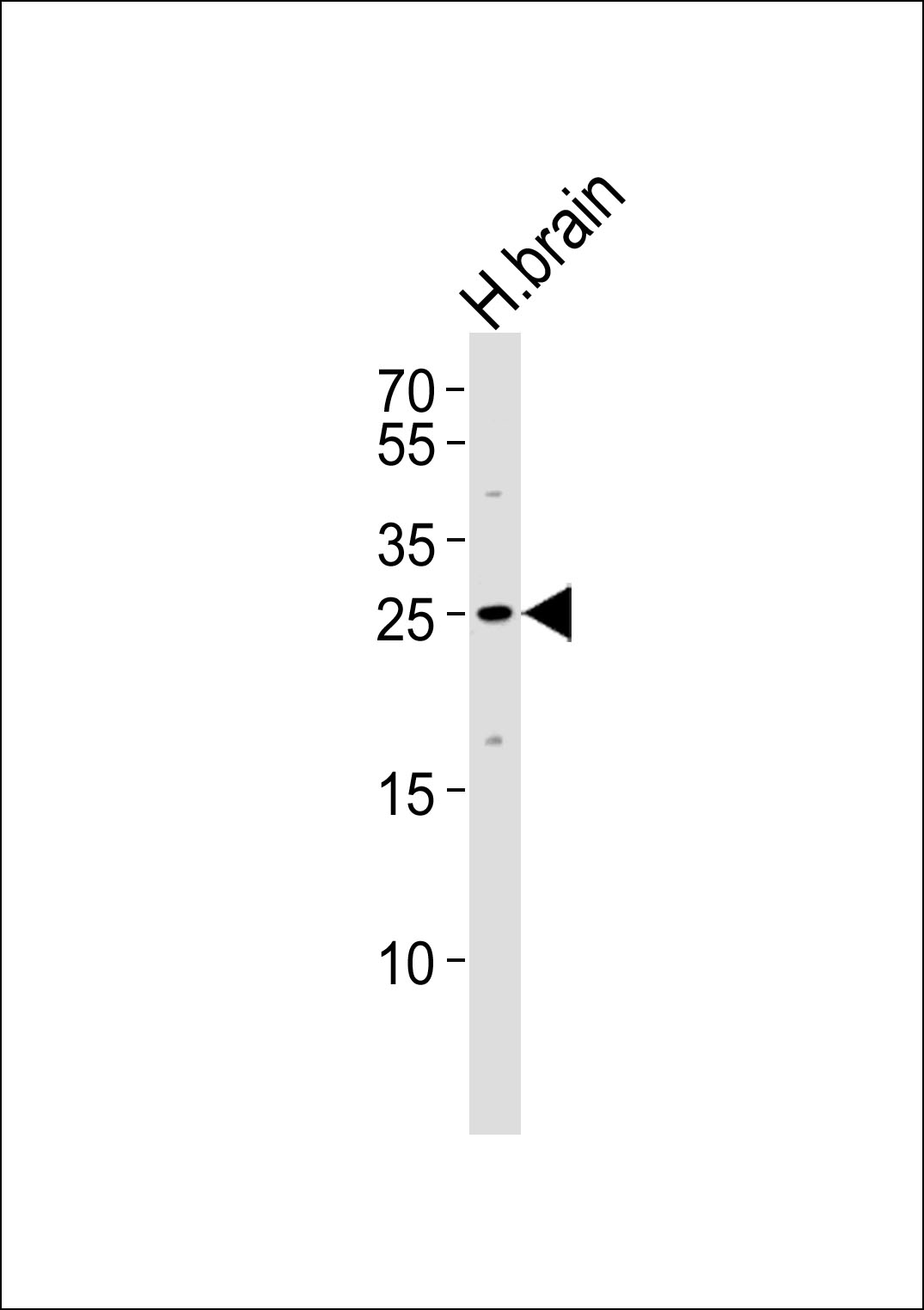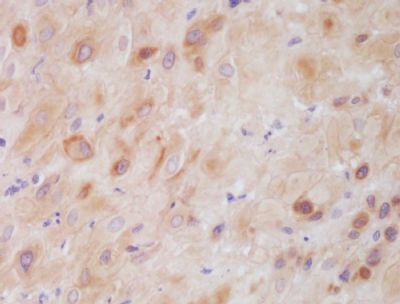CSP Antibody
Protein A Purified Rabbit Polyclonal Antibody (Pab)
- SPECIFICATION
- CITATIONS
- PROTOCOLS
- BACKGROUND

Application
| WB, IHC-P, IHC-F, IF, ICC, E |
|---|---|
| Primary Accession | Q9H3Z4 |
| Reactivity | Human, Mouse, Rat, Rabbit, Sheep, Guinea Pig |
| Host | Rabbit |
| Clonality | Polyclonal |
| Calculated MW | 22 KDa |
| Physical State | Liquid |
| Immunogen | KLH conjugated synthetic peptide derived from human CSP |
| Epitope Specificity | 1-100/198 |
| Isotype | IgG |
| Purity | affinity purified by Protein A |
| Buffer | 0.01M TBS (pH7.4) with 1% BSA, 0.02% Proclin300 and 50% Glycerol. |
| SUBCELLULAR LOCATION | Membrane. Melanosome. Identified by mass spectrometry in melanosome fractions from stage I to stage IV. |
| SIMILARITY | Contains 1 J domain. |
| SUBUNIT | Homodimer (Probable). Interacts with the chaperone complex consisting of HSC70 and SGTA (By similarity). |
| Post-translational modifications | Fatty acylated. Heavily palmitoylated in the cysteine string motif. |
| DISEASE | Neuronal ceroid lipofuscinosis 4B (CLN4B) [MIM:162350]: An adult-onset neuronal ceroid lipofuscinosis. Neuronal ceroid lipofuscinoses are progressive neurodegenerative, lysosomal storage diseases characterized by intracellular accumulation of autofluorescent liposomal material, and clinically by seizures, dementia, visual loss, and/or cerebral atrophy. CLN4B has no visual involvement and is characterized by seizures and other neurologic symptoms. Note=The disease is caused by mutations affecting the gene represented in this entry. |
| Important Note | This product as supplied is intended for research use only, not for use in human, therapeutic or diagnostic applications. |
| Background Descriptions | Cysteine string proteins (CSPs) are synaptic vesicle-associated, secretory vesicle proteins that are involved in Ca2+-regulated exocytosis of synaptic vesicles and modulation of presynaptic transmembrane calcium fluxes in neuroendocrine and endocrine cell types. CSP contains a J-domain that binds HSP 70/HSC 70 chaperone ATPases and a membrane-targeting, palmitoylated cysteine-rich string region. CSPs may act as molecular chaperones in synapses, and mediate conformational folding of components of the vesicular exocytotic machinery. CSP is involved in the fine tuning of neurotransmission through its interaction with receptor-coupled trimeric GTP binding proteins (G proteins) and N-type Ca2+ channels. Two variants of CSP have been described: CSP1; and the 31 amino acid, C-terminally truncated isoform, CSP2. Subcellular fractionation of insulinoma cells shows CSP1 in granular fractions, while the membrane and cytosol fractions contain predominantly CSP2. The fractions also contain additional proteins, presumably CSP dimers. Furthermore, in various mammalian cell lines (including rat brain) CSP1 expression predominates CSP2 expression. |
| Antigen Region | 1-100/198 aa |
| Gene ID | 80331 |
|---|---|
| Other Names | DnaJ homolog subfamily C member 5, Cysteine string protein, CSP, DNAJC5, CSP |
| Target/Specificity | Expressed in pancreas, kidney, skeletal muscle, liver, lung, placenta, brain and heart. |
| Dilution | WB=1:500-2000,IHC-P=1:100-500,IHC-F=1:100-500,ICC=1:100-500,IF=1:100-500,ELISA=1:5000-10000 |
| Format | 0.01M TBS(pH7.4), 0.09% (W/V) sodium azide and 50% Glyce |
| Storage | Store at -20 ℃ for one year. Avoid repeated freeze/thaw cycles. When reconstituted in sterile pH 7.4 0.01M PBS or diluent of antibody the antibody is stable for at least two weeks at 2-4 ℃. |
| Name | DNAJC5 (HGNC:16235) |
|---|---|
| Function | Acts as a general chaperone in regulated exocytosis (By similarity). Acts as a co-chaperone for the SNARE protein SNAP-25 (By similarity). Involved in the calcium-mediated control of a late stage of exocytosis (By similarity). May have an important role in presynaptic function. May be involved in calcium-dependent neurotransmitter release at nerve endings (By similarity). |
| Cellular Location | Cytoplasm, cytosol {ECO:0000250|UniProtKB:Q29455}. Membrane {ECO:0000250|UniProtKB:Q29455}; Lipid-anchor {ECO:0000250|UniProtKB:Q29455}. Cytoplasmic vesicle, secretory vesicle, chromaffin granule membrane {ECO:0000250|UniProtKB:Q29455}. Melanosome. Cell membrane. Note=The association with membranes is regulated by palmitoylation (By similarity). Identified by mass spectrometry in melanosome fractions from stage I to stage IV (PubMed:17081065). {ECO:0000250|UniProtKB:Q29455, ECO:0000269|PubMed:17081065} |
| Tissue Location | Expressed in pancreas, kidney, skeletal muscle, liver, lung, placenta, brain and heart. |

Thousands of laboratories across the world have published research that depended on the performance of antibodies from Abcepta to advance their research. Check out links to articles that cite our products in major peer-reviewed journals, organized by research category.
info@abcepta.com, and receive a free "I Love Antibodies" mug.
Provided below are standard protocols that you may find useful for product applications.
Background
May have an important role in presynaptic function. May be involved in calcium-dependent neurotransmitter release at nerve endings (By similarity).
References
Coppola T.,et al.FEBS Lett. 391:269-272(1996).
Ota T.,et al.Nat. Genet. 36:40-45(2004).
Deloukas P.,et al.Nature 414:865-871(2001).
Mural R.J.,et al.Submitted (SEP-2005) to the EMBL/GenBank/DDBJ databases.
Hattori A.,et al.DNA Res. 7:357-366(2000).
If you have used an Abcepta product and would like to share how it has performed, please click on the "Submit Review" button and provide the requested information. Our staff will examine and post your review and contact you if needed.
If you have any additional inquiries please email technical services at tech@abcepta.com.













 Foundational characteristics of cancer include proliferation, angiogenesis, migration, evasion of apoptosis, and cellular immortality. Find key markers for these cellular processes and antibodies to detect them.
Foundational characteristics of cancer include proliferation, angiogenesis, migration, evasion of apoptosis, and cellular immortality. Find key markers for these cellular processes and antibodies to detect them. The SUMOplot™ Analysis Program predicts and scores sumoylation sites in your protein. SUMOylation is a post-translational modification involved in various cellular processes, such as nuclear-cytosolic transport, transcriptional regulation, apoptosis, protein stability, response to stress, and progression through the cell cycle.
The SUMOplot™ Analysis Program predicts and scores sumoylation sites in your protein. SUMOylation is a post-translational modification involved in various cellular processes, such as nuclear-cytosolic transport, transcriptional regulation, apoptosis, protein stability, response to stress, and progression through the cell cycle. The Autophagy Receptor Motif Plotter predicts and scores autophagy receptor binding sites in your protein. Identifying proteins connected to this pathway is critical to understanding the role of autophagy in physiological as well as pathological processes such as development, differentiation, neurodegenerative diseases, stress, infection, and cancer.
The Autophagy Receptor Motif Plotter predicts and scores autophagy receptor binding sites in your protein. Identifying proteins connected to this pathway is critical to understanding the role of autophagy in physiological as well as pathological processes such as development, differentiation, neurodegenerative diseases, stress, infection, and cancer.



